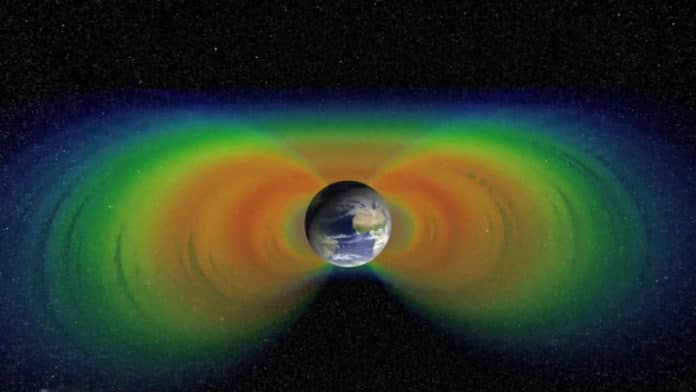Electrically charged particles are trapped by the Earth’s magnetic field, forming the Van Allen radiation belts. Observations show that electrons in this region can have energies above 7 MeV.
However, whether electrons at these ultra-relativistic energies are locally accelerated, or if a combination of both mechanisms is required, has remained an unanswered question in radiation belt physics.
A new study led by researchers from the GFZ German Research Centre for Geosciences shows that electrons in the radiation belts can be accelerated to very high speeds locally. The study shows that the magnetosphere works as a very efficient particle accelerator speeding up electrons to so-called ultra-relativistic energies.
In 2012 NASA launched the Van Allen Probes twin spacecraft mission to explore the origin of the Van Allen Belts. The spacecraft traverse this most harsh environment and conduct detailed measurements in this hazardous region.
The estimations incorporated a full range of particles moving at different speeds and in various directions and plasma waves.
Ongoing observations uncovered that the energy of electrons in the belts could go up to so-called ultra-relativistic energies. These electrons with temperatures over 100 Billion degrees Fahrenheit move so quickly that their energy of motion is a lot higher than their energy of rest given by Einstein’s famous E=mc2 formula. They are quick to the point that the time flow significantly slows down for these particles.
It was amazing to discover these ultra-relativistic electrons. Scientists assumed that such high energies could only be reached by combining two processes: the inward transport of particles from the outer regions of the magnetosphere, which accelerates them, and a local acceleration of particles by plasma waves.
The study suggests that electrons reach such incredible energies locally, in the belts’ heart, by taking all this energy from plasma waves. This process turns out to be extremely efficient.
The unexpected discovery of how the acceleration of particles to ultra-relativistic energies operates in the near-Earth space may help scientists understand the fundamental processes of acceleration on the Sun, near outer planets, and even in the distant corners of the universe where space probes cannot reach.
Journal Reference:
- Allison, H.J., Shprits, Y.Y. Local heating of radiation belt electrons to ultra-relativistic energies. Nat Commun 11, 4533 (2020). DOI: 10.1038/s41467-020-18053-z
